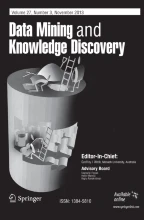Abstract
Classification is a well-studied problem in data mining. Classification performance was originally gauged almost exclusively using predictive accuracy, but as work in the field progressed, more sophisticated measures of classifier utility that better represented the value of the induced knowledge were introduced. Nonetheless, most work still ignored the cost of acquiring training examples, even though this cost impacts the total utility of the data mining process. In this article we analyze the relationship between the number of acquired training examples and the utility of the data mining process and, given the necessary cost information, we determine the number of training examples that yields the optimum overall performance. We then extend this analysis to include the cost of model induction—measured in terms of the CPU time required to generate the model. While our cost model does not take into account all possible costs, our analysis provides some useful insights and a template for future analyses using more sophisticated cost models. Because our analysis is based on experiments that acquire the full set of training examples, it cannot directly be used to find a classifier with optimal or near-optimal total utility. To address this issue we introduce two progressive sampling strategies that are empirically shown to produce classifiers with near-optimal total utility.
Similar content being viewed by others
Explore related subjects
Discover the latest articles, news and stories from top researchers in related subjects.References
Berry M and Linoff G (2004). Data mining techniques for marketing, sales and customer relationship management. Wiley Publishing, Indianapolis, IN
Breiman L, Friedman JH, Olshen RA, Stone CJ (1983) Classification and regression trees. Wadsworth
Caruna R, Joachims T and Backstrom L (2004). KDD-CUP 2004: results and analysis. SIGKDD Explor 6(2): 95–108
Cohn D, Atlas L and Ladner R (1994). Improving generalization with active learning. Mach Learn 15(2): 201–221
Drummond C and Holte R (2006). Cost curves: an improved method for visualizing classifier performance. Mach Learn 65(1): 95–130
Elkan C (2001) The foundations of cost-sensitive learning. In: Proceedings of the Seventeenth International Joint Conference on artificial intelligence, Seattle, WA, pp 973–978
Esposito F, Malerba D and Semeraro G (1997). A comparative analysis of methods for pruning decision trees. IEEE Trans Pattern Anal Mach Intell 19(5): 476–491
Fayyad U, Piatetsky-Shapiro G and Smyth P (1996). From data mining to knowledge discovery in databases.. AI Mag 17: 37–54
Greiner R, Grove A and Roth D (2002). Learning cost-sensitive active classifiers. Artif Intell 39: 137–174
Hettich S, Bay SD (1999) The UCI KDD archive [http://kdd.ics.uci.edu]. University of California, Dept. of Information and Computer Science, Irvine, CA
Hoehn B, Southey F, Holte R, Bulitko V (2005) Effective short-term opponent exploitation in simplified poker. In: Proceedings of the Twentieth National Conference on artificial intelligence, Pittsburgh, PA, pp 783–788
Kapoor A, Greiner R (2005) Learning and classifying under hard budgets. In: Proceedings of the Sixteenth European Conference on machine learning, Porto, Portugal, pp 170–181
Lewis D, Catlett J (1994) Heterogeneous uncertainty sampling for supervised learning. In: Proceedings of the Eleventh International Conference on machine learning, New Brunswick, NJ, pp 148–156
Li R, Belford G (2002) Instability of decision tree classification algorithms. In: Proceedings of the Eighth ACM SIGKDD International Conference on knowledge discovery and data mining, Edmonton, Canada, pp 570–575
Martin JK, Hirschberg DS (1996) On the complexity of learning decision trees. In: Proceedings of the fourth International Symposium on artificial intelligence and mathematics, Fort Lauderdale, Florida
Melville P, Saar-Tsechansky M, Provost F, Mooney R (2005) Economical active-feature value acquisition through expected utility estimation. In: Proceedings of the First International Workshop on Utility-Based Data Mining, Chicago, IL, pp 10–16
Newman DJ, Hettich S, Blake CL, Merz CJ (1998) UCI Repository of machine learning databases [http://www.ics.uci.edu/~mlearn/MLRepository.html]. University of California, Department of Information and Computer Science, Irvine, CA
Provost F and Fawcett T (2001). Robust classification for imprecise environments. Mach Learn 42: 203–231
Provost F, Jensen D, Oates T (1999) Efficient progressive sampling. In: Proceedings of the Fifth International Conference on knowledge discovery and data mining, San Diego, CA, pp 23–32
Quinlan JR (1993). C4.5: programs for machine learning. Morgan Kaufmann, San Mateo, CA
Snedecor GW and Cochran WG (1989). Statistical methods. Iowa State University Press, Ames, OH
Turney P (2000) Types of cost in inductive concept learning. In: Workshop on Cost-Sensitive Learning at the Seventeenth International Conference on machine learning, Stanford, CA
Van Rijsbergen CJ (1979) Information retrieval, 2nd edn. Butterworth, London
Veeramachaneni S, Avesani P (2003) Active sampling for feature selection. In: Proceedings of the Third IEEE International Conference on data mining, Melbourne, Florida, pp 665–668
Weiss GM and Provost F (2003). Learning when training data are costly: the effect of class distribution on tree induction. J Artif Intell Res 19: 315–354
Weiss GM, Saar-Tsechansky M and Zadrozny B (2005). Report on UBDM-05: workshop on utility-based data mining. SIGKDD Explor 17(2): 145–147
Zadrozny B, Weiss GM and Saar-Tsechasnky M (2006). UBDM-2006: utility-based data mining workshop report. SIGKDD Explor 8(2): 98–101
Author information
Authors and Affiliations
Corresponding author
Additional information
Responsible editor: Geoff Webb.
Rights and permissions
About this article
Cite this article
Weiss, G.M., Tian, Y. Maximizing classifier utility when there are data acquisition and modeling costs. Data Min Knowl Disc 17, 253–282 (2008). https://doi.org/10.1007/s10618-007-0082-x
Received:
Accepted:
Published:
Issue Date:
DOI: https://doi.org/10.1007/s10618-007-0082-x
